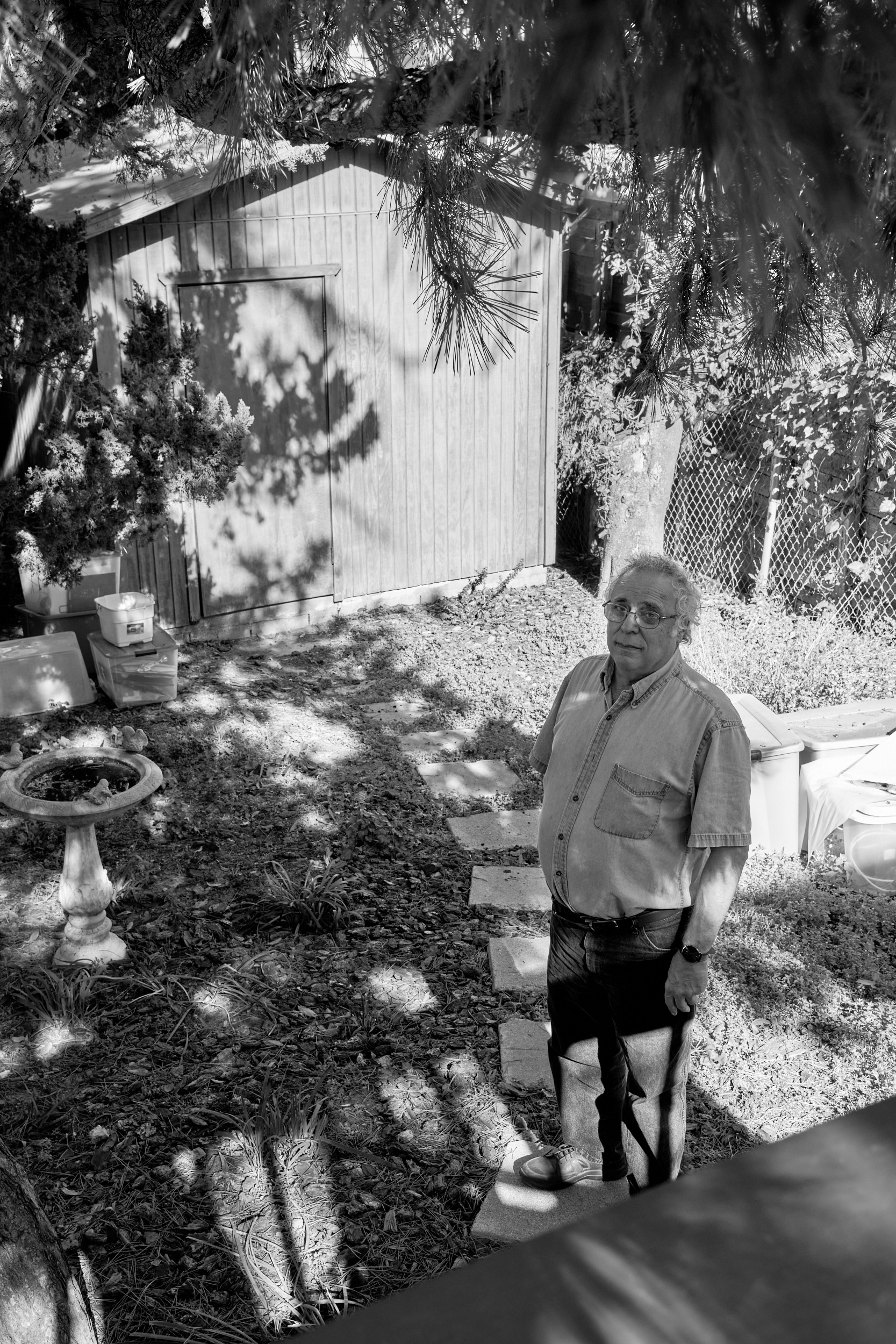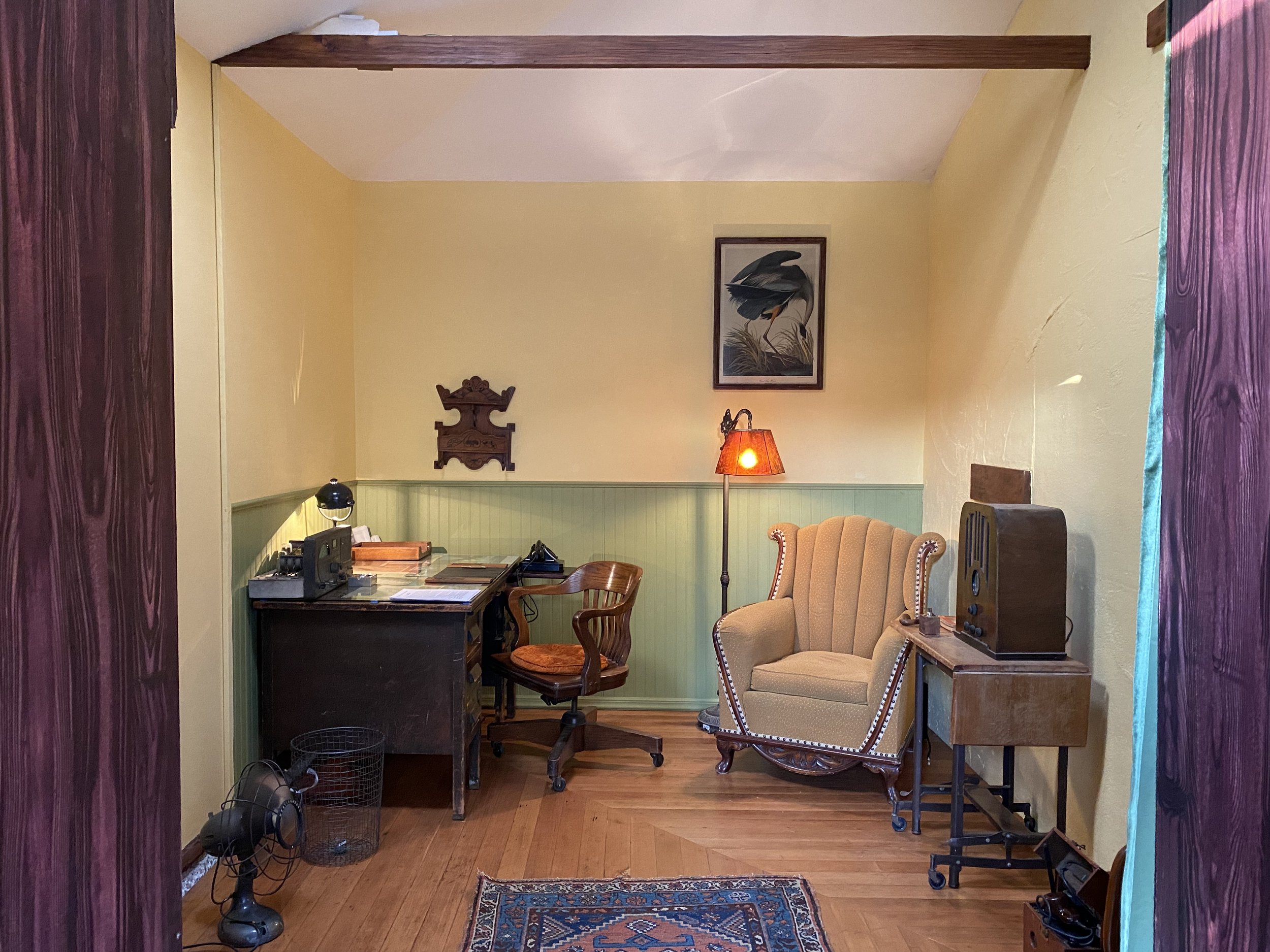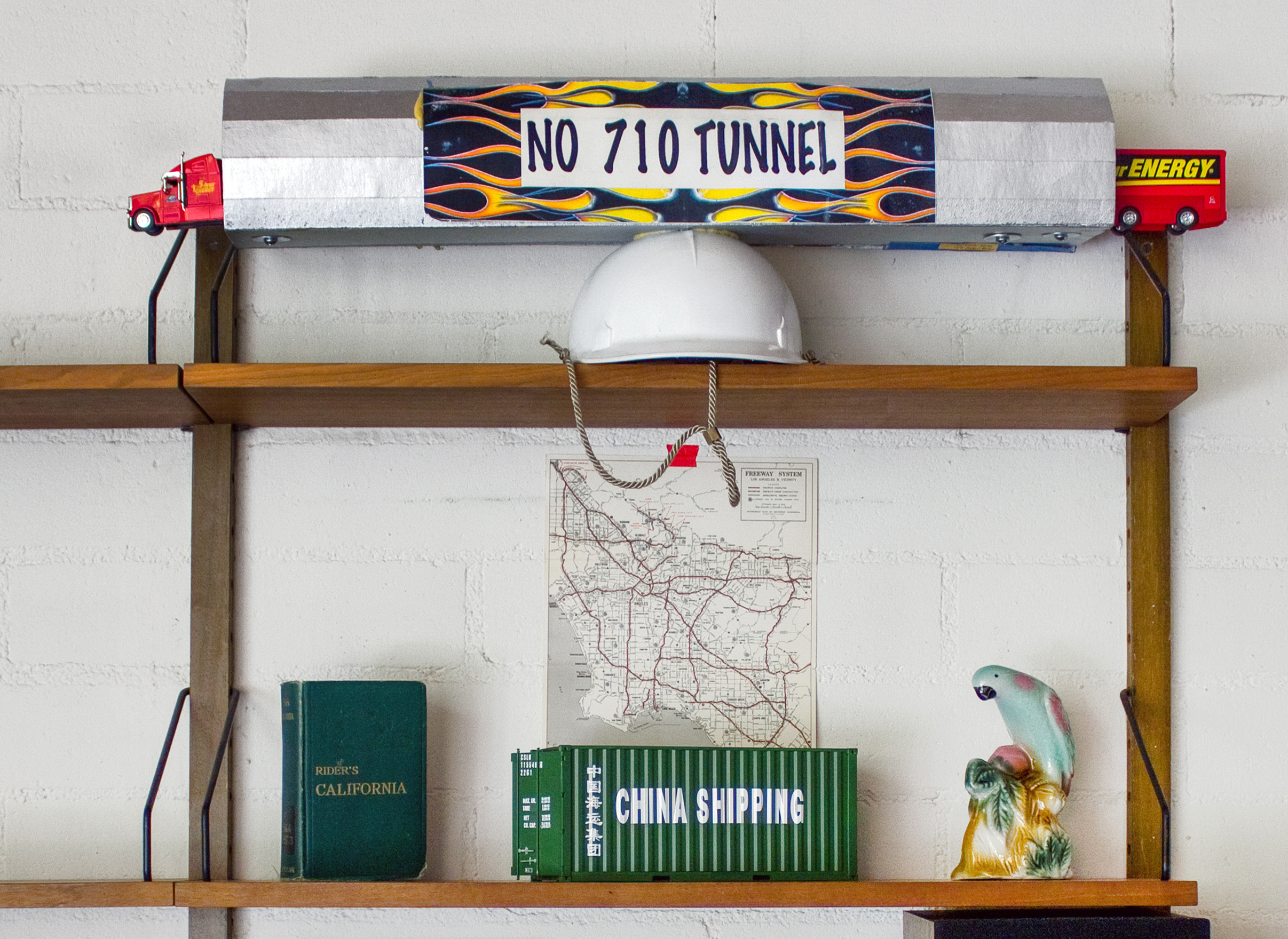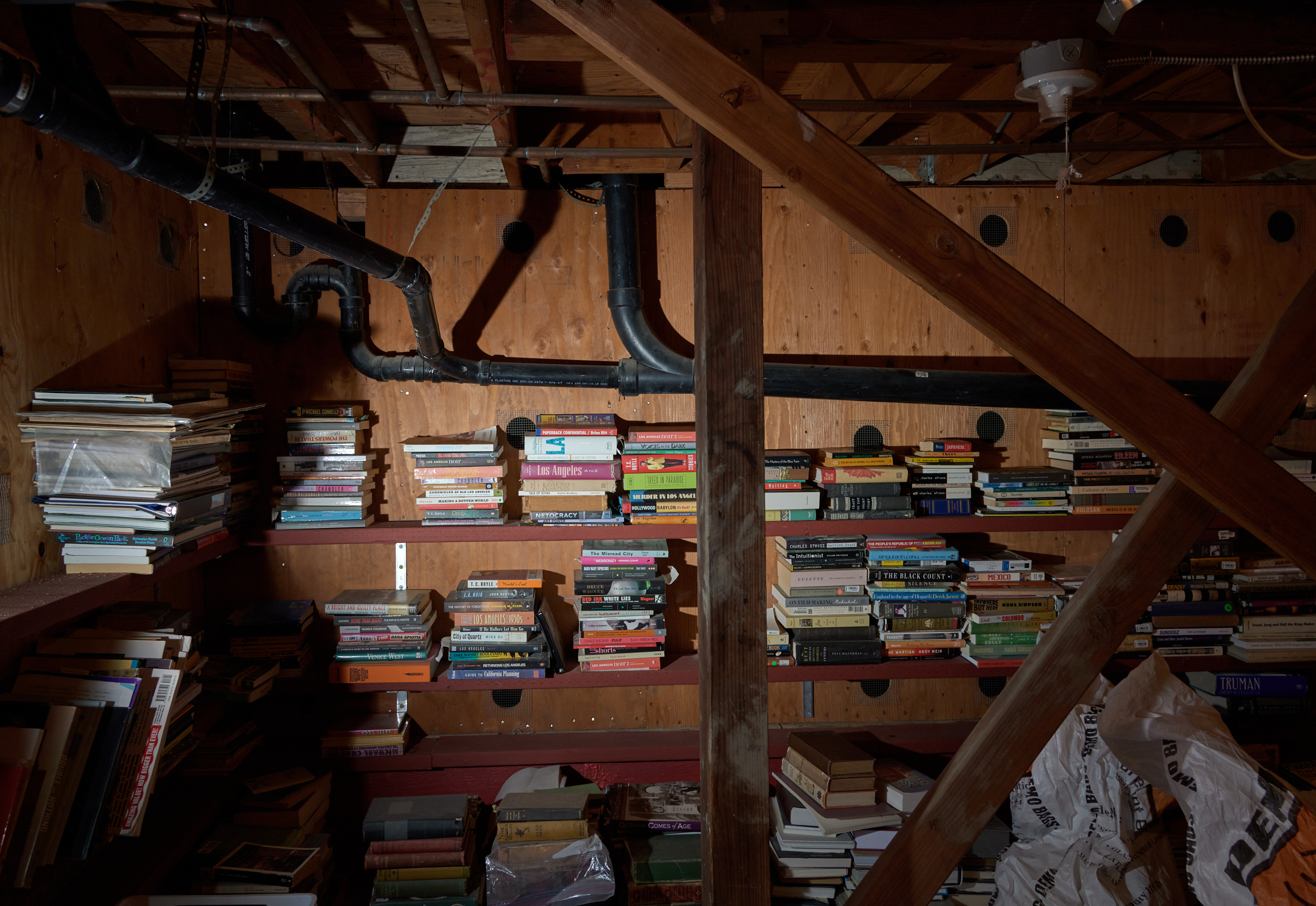The unconscious takes many shapes. For the writer Norman Klein, these shapes include the libraries he builds on his property. Here, Julia Tcharfas searches through backyards and basements, offices and archives for a clue to her fascination with the collector’s mind.

Norman Klein in his backyard with one of his library sheds in the background, 2022. Photo: Brica Wilcox.
I think a lot about the imaginary spaces created by things moving in and out of storage. Film prop houses full of objects organized by period and genre destined to circulate through constructed worlds. All the bits in archives and collections moving in and out of context. The afterlives of stuff we keep and leave behind in estate sales, memory boxes, oblivion basements, the vaults that carry our unconscious.
I heard that artist David Ireland dug a hole under his home in San Francisco to make a room for his thoughts. Long since converted into the underground archive of 500 Capp Street, the fragile mementos of the artist’s thinking survive, boxed and barcoded, part of the official history of his life and work. Under the ground is good for storing, but also for finding things. Doheny found oil digging only a few feet deep.
The other day I saw a storage room in a house in Burbank that had been converted into the office of a WWII spy. It looked like a time capsule, furnished with a scuffed walnut desk, a period reading nook, and a couple of portable wood case radios seemingly untouched since 1945. Two stormy lithographs hung on the yellow walls.
As I moved through the room, trying to read it from different angles, I accidentally backed into a workbench and toppled a metal ashtray to the floor, scattering cigarette butts and a cloud of ash. The flipside of the ashtray revealed a Warner Brothers barcode. It was a prop. The memory stuff on the desk, the antique furnishings, the spy himself, all were a careful composition by writer and historian Norman Klein, assembled for his exhibition at Patrick Winfield Vogel’s Office Space in Burbank. For Klein, this elaborate scene, entitled The Secret Rise of Skunk Works: 1937 – December 6, 1941, served as a kind of postscript or a lost chapter of the multimedia novel he published in 2016 with his partner, the cultural historian Margo Bistis, The Imaginary 20th Century.

Norman Klein, The Secret Rise of Skunk Works: 1937–December 6, 1941, 2022. Installation detail. Courtesy of the artist and Office Space, Burbank. Photo: Evan Walsh.
Both the room and the set within it were tied up with the local history of the Skunk Works, a top-secret aviation plant operated by the Lockheed Corporation in the foothills of Burbank until the late 1980s. To camouflage their military facilities at the peak of the Second World War, Lockheed summoned special effects artists from nearby film studios. Scenography painters concealed airstrips and parking lots with painted alfalfa fields. Airplane factories were shrouded with backdrops made of chicken wire and canvas. Dozens of spies pretending to be somebody else, like Klein’s protagonist Barney G., worked undercover out of rooms in suburban homes. Lockheed is “the reason Burbank looks the way it does,” Klein told me: “like an idea of a suburb.”
The black and white archival photographs documenting the suburban camouflage concealing Lockheed sat on Barney’s desk—a scene within a scene within a scene. A set is already an exercise in mimicry, but The Secret Rise of Skunk Works was not built as a simulation, but as a site-specific mirage. The “real” here is a documentary illusion, a special effect stirred by the counterfeit breeze of a prop fan, but to call the installation “fiction” is also an easy target—a sitting duck. “I know why I’m here,” says the stuffed duck on the shelf with its eye on Barney’s empty chair.
Projects like The Secret Rise of Skunk Works have a way of conjuring entire worlds from deep storage. My own practice involves these occult mechanics; cryptic details of objects and their exhibition; the space where the archive and the misremembered reveal new fictions and myths. In 2017, I started a project space in my living room called Before Present, dedicated to archives that are assembled, borrowed, or fabricated for exhibitions. The shows are a nod to sixteenth-century cabinets of curiosity. They display things dug up from under people’s beds, basements, and sheds; relics of postwar science and technology; fragments of the 20th century’s environmental and future imaginaries: Y2K, post-apocalyptic rehearsals, the life worlds of ticks, and the afterlife of the freeways.

Julia Tcharfas and Tim Ivison, 710, 2018. Installation view. Courtesy of the artists and Before Present, Pasadena. Photo: Julia Tcharfas.
In 2018, I invited Klein to record an audio tour for a Before Present project about an unfinished freeway in Los Angeles. This tour would span the length of the 710 from Long Beach to Pasadena, including a six mile stretch where the freeway was planned but never built. Klein had written of this nonevent in his 1997 book, The History of Forgetting: Los Angeles and the Erasure of Memory, calling it the “Great White Whale,” a project so unpopular that it had become the longest development dispute in American history. The house I live in with my partner, Tim Ivison, stands on the path of the proposed freeway. This missing part of the road, known as “the gap,” extends across three neighborhoods in northeast LA. The invisible road has left a visible landscape shaped by dispute and waiting.
It also left behind a 60-year-long paper trail of speculative proposals and plans. I began the search for the 710 archives through conversations with my neighbors. I found an activists’ “war room” that housed decades of newspaper clippings in tall metal file cabinets, a garage full of protest and parade paraphernalia, and attic archives belonging to a group known as the No 710 Action Committee. Ivison and I assembled and displayed these collections in an exhibition, with Klein’s audio as the guide.
Through this first collaboration, Klein and I recognized in each other a kind of archive fever. This connection has led to countless conversations about second-hand books, antique replicas, obsolete technologies, and counterfactual histories of Los Angeles. I’ve learned from Klein to see things not in the past tense, but in the subjunctive mood. As Klein puts it, “Things are never erased. They go into the stomach of the mind and live there like bacteria.” It’s like those things in storage, waiting to bubble up, to bring back the bacteria of history. “Like an autoimmune deficiency,” adds Klein.
During one of our many conversations in the front room of Klein’s house in Highland Park, I asked him how he stores and organizes his writer’s library, his collection of collections. Klein pointed to the street where a walnut tree was once uprooted by the wind. It collapsed onto another tree, splitting it down the middle, but the suckers grew on. The split tree made a copy of itself and grew a new tree inside the dying one.

The underground library under Norman Klein’s home in Highland Park, 2022. Photo: Brica Wilcox.
As Klein explained, “If there is an architecture of basements and minds, it can’t just be human. It’s something else. Things grow there. Things gather there. Things get lost there. It’s generational. There are insects there. There are lizards there. There is rot there, time, nature, whatever that’s called.”
An architecture of basements and minds. This is the system by which Klein’s library takes shape. The well-appointed front room where we meet conceals a deluge of thinking, reading, and writing. Thousands of books, documents, manuscripts, binders, newspaper clippings, dime novels, maps, fragments, and memorabilia that, in one way or another, relate to Klein’s ongoing research have been hidden backstage in a series of libraries in the backyard. There is the history of Los Angeles section. A shed built for The Vatican to Vegas: A History of Special Effects (2004) is there, next to another for Freud in Coney Island and Other Tales (2006). Bistis’s office is alongside, dedicated to her work on Artaud, modernism, art history, and their cowritten novella. Klein points out the prized bits of the collections as we walk through the many libraries. There is a plot generator for crime dramas. A collection of unsolved police cases. A section on the history of premonitions of wars. Melodramas. Adventure stories of all kinds. Noir paperbacks with crime maps on the covers. And cabinets full of ongoing work.
Now researching a new book, called The Archaeology of the Present: The Dismantling of the American Psyche, Klein is carving out some space underground. Last summer, he began to dig a hole under his home to make room for subterranean stacks. By winter, Klein was unpacking his library into stalagmites on the freshly dried concrete floor and onto the weather-treated shelves—thoughts and notes on the crumbling American psyche soon to be stored under Klein’s own home. For me, who have found my best ideas in storage, the lesson seems clear. I must dig very deep holes. x

Julia Tcharfas is an artist in Pasadena. She founded Before Present in 2017 in the living room of her home.